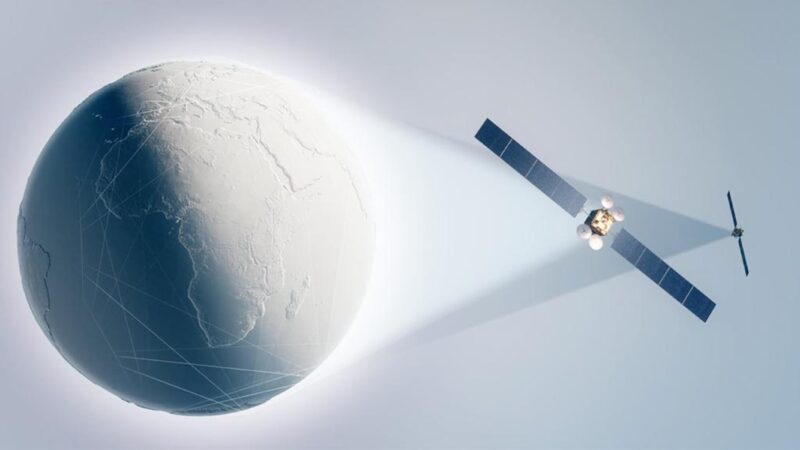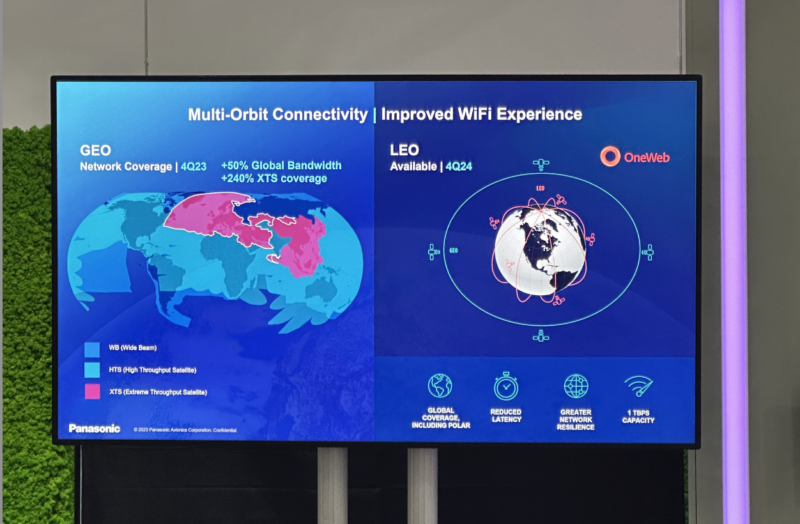It’s APEX EXPO/FTE Global in Long Beach this week, so we’re going to see a few passenger experience headlines bubble through.
Let’s kick off with an announcement from Panasonic Avionics– which has been selected by Airbus as a managed service provider for its Airspace Link HBCplus (HBCplus) Ku solution.

This selection firms up an earlier MoU phase which was revealed at Aircraft Interiors Expo in June this year.
HBCplus is something that is not normally seen by the passenger directly – however, it is important, as it is Airbus’ high bandwidth connectivity solution that will be offered as a line-fit catalogue or retrofit option on all its aircraft programs. We covered this at its launch at AIX 2022.
This in turn allows connectivity from the aircraft to the sky or ground.
As a Managed Service Provider for HBCplus, Panasonic Avionics will be able to integrate its multi-orbit connectivity service, a blend of LEO (low earth orbit) and GEO (geostationary equatorial orbit) satellite constellations, onto Airbus aircraft, using an electronically steered antenna (ESA) with a multi-beam operation that can simultaneously access Panasonic Avionics’ LEO and GEO networks.
Panasonic Avionics’ in-flight connectivity services are powered by its global network of high-speed, high-bandwidth satellites, and have been selected by more than 70 of the world’s leading airlines. The LEO network will be powered by a partnership with OneWeb, building on a partnership to market, sell and support its high-speed, low-latency LEO in-flight broadband services to commercial airlines worldwide.

Panasonic and OneWebs network overlayed, with the planned expansion of the Panasonic Network (taken at AIX 2023).
It also marks an important step as Panasonic Avionics is the first OneWeb partner to make its connectivity available through HBCplus. In turn, by offering both GEO and LEO solutions, this will offer coverage on 99.6% of the world’s flight routes.
The company’s dedication to a multi-orbit strategy will offer airlines more choices, with top-tier products that support high-speed and low-latency connectivity solutions.
In Quotes
John Wade, Vice President of Panasonic Avionics’ In-flight Connectivity Business Unit, said:
“HBCplus aligns perfectly with our multi-orbit strategy and will seamlessly integrate with our LEO and GEO connectivity solutions. We understand the needs of airlines and OEMs alike. By offering HBCplus we are providing airlines with a greater choice of connectivity services, and ultimately enhancing the passenger experience.”
Maximilian Ruecker, VP of Cabin Procurement Seats, IFE and Electronics at Airbus, said:
“Airbus’ vision is to make state of the art IFC technology available to its customers while offering the best choice of connectivity providers. As such we are pleased to be able to include Panasonic Avionics as a player in this program. We are looking forward to continuing to enrich this cooperation.”
What does this mean for the passenger?
For the passenger – the upshot is simple – a better inflight Wi-Fi experience. With better coverage and performance, this opens the door to more fluid in-flight browsing and streaming experiences, as well as better response times for low-latency applications.
For the passenger who demands to be connected in the air – and that only increases day by day, this will be welcome, as airlines consider what technologies to deploy and how to deploy them.
Welcome to Economy Class and Beyond. Your no-nonsense guide to network news, honest reviews, in-depth coverage, unique research, as well as the humour and madness I only know how to deliver.
Our Social Media pool has expanded. You can find us across most networks as @economybeyond on Twitter, Mastodon, BlueSky, Threads, as well as Instagram!
Also, remember that we are part of the BoardingArea community, bringing you the latest frequent flyer news from around the world.